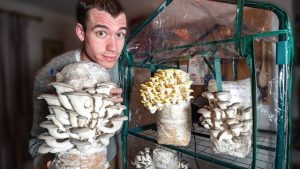
Mushroom cultivation has been captivating farmers, gardeners, and enthusiasts for centuries. With their earthy flavors, unique textures, and impressive nutritional profiles, mushrooms have become beloved ingredients in various cuisines around the world. But have you ever wondered what it takes to grow these fascinating fungi from scratch? In this article, we will embark on a journey through the intricate art of mushroom cultivation, unraveling the secrets of successful mushroom growing along the way. So, put on your gardening gloves and prepare to discover the hidden wonders that lie beneath the surface of this extraordinary endeavor.
Grow Mushrooms
Choosing the Right Mushroom Varieties
Mushroom growing offers a wide array of possibilities when it comes to selecting the right varieties. With countless options to explore, it’s important to consider certain factors that can help determine the most suitable mushrooms to cultivate.
Climate Compatibility: Pay close attention to the climatic conditions of your region. Different mushrooms thrive in various environments, so choose varieties that are well-suited to your local climate. Some prefer cooler temperatures, while others flourish in warmer and more humid settings.
Growing Method and Space: Assess the availability of resources and the space you have for cultivation. Some mushrooms require specific growing methods, such as wood logs or compost. Others can be grown indoors in containers or even on substrates like straw or sawdust. Consider the resources you have at hand and select the varieties that align with your chosen growing method and available space.
Desired Culinary Use: Think about the flavor and texture profiles you would like to incorporate into your culinary creations. Each mushroom variety offers unique attributes that can elevate the taste and presentation of meals. Consider the dishes you plan to prepare and select mushrooms that will complement your culinary ambitions.
By considering these factors, you can make informed decisions when it comes to choosing the right mushroom varieties for your growing endeavors. Remember, experimentation is key, and it’s always exciting to explore new varieties and witness the wonders of mushroom cultivation.
Creating the Ideal Growing Environment
To successfully grow mushrooms, creating the right environment is essential. Paying attention to factors such as temperature, humidity, and lighting can greatly influence the growth and development of these fascinating fungi.
Firstly, maintaining the ideal temperature is crucial for successful mushroom cultivation. Different mushroom species have varying temperature requirements, but generally, a range of 55-65 degrees Fahrenheit (13-18 degrees Celsius) is suitable for most varieties. Using a temperature-controlled room or a dedicated growing chamber can help maintain the desired conditions consistently.
In addition to temperature, controlling humidity levels is equally important. Mushrooms thrive in moist environments, so keeping the humidity between 80-90% is essential for their growth. Mist the growing area periodically or consider using a humidifier to maintain the necessary moisture levels. However, it’s important to avoid over-saturating the environment, as excessive moisture can lead to fungal diseases.
Lastly, providing adequate lighting is essential for mushroom growth, although not all varieties require direct light exposure. Some mushrooms prefer low-light conditions, while others may prefer indirect or filtered light. Understanding the lighting needs of the specific mushroom species you are growing is crucial to ensuring optimal growth. Consider using artificial lights or positioning your growing setup near a window to provide the required lighting conditions.
By creating and maintaining an environment with the right temperature, humidity, and lighting, you can maximize the success of your mushroom growing endeavors. Taking the time to fine-tune these factors will greatly contribute to the overall health and productivity of your mushroom cultivation.
Harvesting and Enjoying the Fruits of Your Labor
Once your mushroom crops have reached their peak maturity, it is time to harvest and savor the rewards of your hard work. This is an exciting stage in the mushroom growing process, as you get to witness the transformation from tiny fungi to delightful edible treasures.
To harvest your mushrooms, gently twist or cut the mature mushrooms at the base of their stems. It is crucial to handle them with care to avoid damaging the delicate flesh. Remember to only harvest the fully grown mushrooms, leaving the smaller ones to continue developing.
After harvesting, give your mushrooms a quick visual inspection to ensure they are free from any signs of decay or contamination. It is best to use them immediately for ultimate freshness and flavor. However, if you need to store them, place them in a paper bag or a breathable container to prevent moisture buildup that can lead to spoilage.
Now that you have successfully harvested your mushrooms, it’s time to enjoy the unique flavors and textures they offer. Sautee them in butter or olive oil with some garlic and herbs for a simple yet delicious side dish. Alternatively, you can add them to your favorite pasta, stir-fries, or soups for an earthy and savory twist.
Remember, mushroom growing is an ongoing learning process, and each harvest presents an opportunity to refine your techniques and explore new varieties. So, don’t be afraid to experiment with different growing methods and recipes to make the most of your homegrown mushrooms. Bon appétit!
















